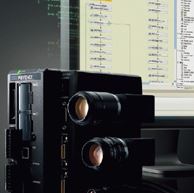 Multinational reduces risk of human error in production lines thanks to vision system
Multinational reduces risk of human error in production lines thanks to vision system
December 1, 2014 REDWIRE is news you can use from leading suppliers. Powered by FRASERS.
Posted by Keyence Canada
KEYENCE is a global leader in the development and manufacturing of sensing equipment including automation sensors, measu... Read more
Subscribe
Free REDWIRE e-newsletter

Every minute, 15,000 patients around the world take a dose of medication produced at GlaxoSmithKline’s (GSK) site in Evreux, France. The site produces 130 million boxes of inhaled forms (aerosols, inhaled products) each year, and exports 85 per cent of its production to 130 countries. This high production volume entails a highly complex traceability system.
One of the inhaled forms produced by GSK is the Diskus, a multi-dose powder inhaler that delivers a metered dose of medication. The marking of each Diskus is checked using a three-camera XG vision system. The first camera uses OCR to check an in-house code that is engraved with a YAG laser. The second checks the placement and diameter of the label, inspects it for tears and makes sure the legal notices printed on it are legible. The label is printed on a white background at a rate of 110 to 150 strokes per minute. The last camera is used to check a special label with a black background used for the Japanese market.
“We were looking for a vision system that did not require any direct operator intervention and thus would eliminate the risk of incorrect adjustments,” explains Christophe Fourcin of GlaxoSmithKline. “Operators simply enter the code of the product to be inspected into the PLC controlling the vision system. That way they don’t have to deal with the complex matter of programming the 30 or so sizes used.
“The very nature of the detection performed means that we have to routinely make changes to the vision system. That’s one of the reasons why we chose Keyence’s XG vision system. We wanted to have a tool that was ours and that we could modify as needed,” says Fourcin.
He says the system is easy to set up. Keyence’s engineer provided GSK with the programming template, and the company took it from there.
“I make the necessary changes myself, which I learnt how to do during a one-day training session provided by Keyence,” says Fourcin.
He adds that the vision system integrated very easily with the PLC, and that detection is stable over time and does not cause any false rejects.
The XG vision system is part of GlaxoSmithKline’s full process control system.
“Our aim is to reduce human intervention to a minimum in order to increase the reliability of our processes. The next step is to control the PLC remotely with a takt time solution,” says Fourcin. ”Once that is done, detection with the Keyence system will be fully automated and centralized.”
Share
Posted by Keyence Canada
KEYENCE is a global leader in the development and manufacturing of sensing equipment including automation sensors, measu... Read more